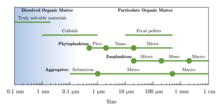Helle Ploug | |
|---|---|
| Alma mater | Aarhus University |
| Scientific career | |
| Thesis | Light and photosynthesis in dense populations of microalgae (1996) |
Helle Ploug is marine scientist known for her work on particles in seawater. She is a professor at the University of Gothenburg, and was named a fellow of the Association for the Sciences of Limnology and Oceanography in 2017.
Education and career
Ploug grew up in Denmark. [1] She has an M.Sc. (1992) [2] and a Ph.D. (1996) from Aarhus University. Following her Ph.D. she did postdoctoral work at the Max Planck Institute for Marine Microbiology and the University of Copenhagen. Starting in 2006 she was a scientist at the Alfred Wegener Institute for Polar and Marine Research, [3] and in 2008 she moved to Stockholm University where she had a Marie Curie fellowship. [1] In 2006 she became an associate professor at the University of Gothenburg where she was promoted to professor in 2013. [3]
Research
Ploug's early research used fiber optic sensors to measure light in marine sediments. [4] [5] She went on to examine how particles assemble in marine systems. [6] [7] Her work on particles includes developing methods to quantify bacterial use of particles, [8] [9] and the implications for consumption of particles produced by copepods. [7] [10] Ploug has developed methods to measure how fast particles sink through the ocean [11] and the rate sinking particles are converted into carbon dioxide. [12] Her recent research has focused on measurements of biogeochemical cycling at the single cell level using Nanoscale secondary ion mass spectrometry. [13] [14]

Selected publications
- Simon, M; Grossart, Hp; Schweitzer, B; Ploug, H (2002). "Microbial ecology of organic aggregates in aquatic ecosystems". Aquatic Microbial Ecology. 28: 175–211. doi: 10.3354/ame028175. ISSN 0948-3055.
- Ploug, H; Kühl, M; Buchholz-Cleven, B; Jørgensen, Bb (1997). "Anoxic aggregates - an ephemeral phenomenon in the pelagic environment?". Aquatic Microbial Ecology. 13: 285–294. doi: 10.3354/ame013285. ISSN 0948-3055.
- Ploug, Helle; Iversen, Morten Hvitfeldt; Fischer, Gerhard (2008). "Ballast, sinking velocity, and apparent diffusivity within marine snow and zooplankton fecal pellets: Implications for substrate turnover by attached bacteria". Limnology and Oceanography. 53 (5): 1878–1886. Bibcode: 2008LimOc..53.1878P. doi: 10.4319/lo.2008.53.5.1878. S2CID 11961354.
- Ploug, H; Grossart, Hp; Azam, F; Jørgensen, Bb (1999). "Photosynthesis, respiration, and carbon turnover in sinking marine snow from surface waters of Southern California Bight:implications for the carbon cycle in the ocean". Marine Ecology Progress Series. 179: 1–11. Bibcode: 1999MEPS..179....1P. doi: 10.3354/meps179001. ISSN 0171-8630.
- Iversen, M. H.; Ploug, H. (2010-09-07). "Ballast minerals and the sinking carbon flux in the ocean: carbon-specific respiration rates and sinking velocity of marine snow aggregates". Biogeosciences. 7 (9): 2613–2624. Bibcode: 2010BGeo....7.2613I. doi: 10.5194/bg-7-2613-2010. ISSN 1726-4189.
Awards and honors
In 2017 Ploug was named a fellow of the Association for the Sciences of Limnology and Oceanography. [15]
References
- ^ a b "Autobiographical sketches: Helle Ploug". Oceanography. 27 (4): 197. December 17, 2015.
- ^ Ploug, Helle. Lys og fotosyntese i danske kystsedimenter (Light and photosynthesis in danish coastal sediments). www.worldcat.org (Thesis) (in Danish). Retrieved 2022-12-31.
- ^ a b "Helle Ploug | University of Gothenburg". www.gu.se. Retrieved 2022-12-31.
- ^ Ploug, Helle; Lassen, Carsten; Jorgensen, Bo Barker (1993). "Action spectra of microalgal photosynthesis and depth distribution of spectral scalar irradiance in a coastal marine sediment of Limfjorden, Denmark". FEMS Microbiology Ecology. 12 (2): 69–78. doi: 10.1111/j.1574-6941.1993.tb00018.x.
- ^ Lassen, Carsten; Ploug, Helle; Jorgensen, Bo Barker (1992). "A fibre-optic scalar irradiance microsensor: application for spectral light measurements in sediments". FEMS Microbiology Letters. 86 (3): 247–254. doi: 10.1111/j.1574-6968.1992.tb04816.x.
- ^ Ploug, H; Kühl, M; Buchholz-Cleven, B; Jørgensen, Bb (1997). "Anoxic aggregates - an ephemeral phenomenon in the pelagic environment?". Aquatic Microbial Ecology. 13: 285–294. doi: 10.3354/ame013285. ISSN 0948-3055.
- ^ a b Simon, M; Grossart, Hp; Schweitzer, B; Ploug, H (2002). "Microbial ecology of organic aggregates in aquatic ecosystems". Aquatic Microbial Ecology. 28: 175–211. doi: 10.3354/ame028175. ISSN 0948-3055.
- ^ Ploug, H; Grossart, Hp (1999). "Bacterial production and respiration in suspended aggregates - a matter of the incubation method". Aquatic Microbial Ecology. 20: 21–29. doi: 10.3354/ame020021. hdl: 21.11116/0000-0005-482C-A. ISSN 0948-3055.
- ^ Ploug, Helle; Grossart, Hans-Peter (2000). "Bacterial growth and grazing on diatom aggregates: Respiratory carbon turnover as a function of aggregate size and sinking velocity". Limnology and Oceanography. 45 (7): 1467–1475. Bibcode: 2000LimOc..45.1467P. doi: 10.4319/lo.2000.45.7.1467. S2CID 86128321.
- ^ Ploug, Helle; Iversen, Morten Hvitfeldt; Koski, Marja; Buitenhuis, Erik Theodoor (2008). "Production, oxygen respiration rates, and sinking velocity of copepod fecal pellets: Direct measurements of ballasting by opal and calcite". Limnology and Oceanography. 53 (2): 469–476. Bibcode: 2008LimOc..53..469P. doi: 10.4319/lo.2008.53.2.0469. hdl: 21.11116/0000-0001-CDA2-1. S2CID 17102955.
- ^ Ploug, Helle; Terbrüggen, Anja; Kaufmann, Anna; Wolf-Gladrow, Dieter; Passow, Uta (2010). "A novel method to measure particle sinking velocity in vitro, and its comparison to three other in vitro methods: Sinking velocity of marine snow". Limnology and Oceanography: Methods. 8 (8): 386–393. doi: 10.4319/lom.2010.8.386. S2CID 53599542.
- ^ Iversen, M. H.; Ploug, H. (2010-09-07). "Ballast minerals and the sinking carbon flux in the ocean: carbon-specific respiration rates and sinking velocity of marine snow aggregates". Biogeosciences. 7 (9): 2613–2624. Bibcode: 2010BGeo....7.2613I. doi: 10.5194/bg-7-2613-2010. ISSN 1726-4189.
- ^ Klawonn, Isabell; Lavik, Gaute; Böning, Philipp; Marchant, Hannah K.; Dekaezemacker, Julien; Mohr, Wiebke; Ploug, Helle (2015-08-04). "Simple approach for the preparation of 15−15N2-enriched water for nitrogen fixation assessments: evaluation, application and recommendations". Frontiers in Microbiology. 6: 769. doi: 10.3389/fmicb.2015.00769. ISSN 1664-302X. PMC 4523818. PMID 26300853.
- ^ Svedén, Jennie B.; Adam, Birgit; Walve, Jakob; Nahar, Nurun; Musat, Niculina; Lavik, Gaute; Whitehouse, Martin J.; Kuypers, Marcel M. M.; Ploug, Helle (2015). Olson, Julie (ed.). "High cell-specific rates of nitrogen and carbon fixation by the cyanobacterium Aphanizomenon sp. at low temperatures in the Baltic Sea". FEMS Microbiology Ecology. 91 (12): fiv131. doi: 10.1093/femsec/fiv131. ISSN 1574-6941. PMID 26511856.
- ^ "ASLO Fellows". ASLO. Retrieved 2022-12-31.
External links
- Helle Ploug publications indexed by Google Scholar